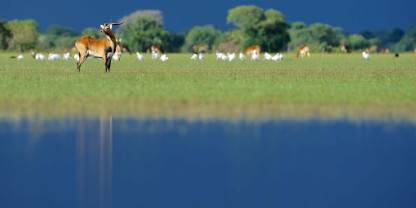Average Expert Rating
Rating Breakdown
Write a User ReviewWhere water meets the sky
Contrary to the diversity of the birds, there isn’t a lot of variety when it comes to mammals. I was mainly interested in seeing the endemic black lechwe and I wasn’t disappointed. Even before reaching the wetland, I saw thousands of them on the floodplains. These gracious antelope are adapted to marshy conditions and seeing them run at full speed through deep water is a phenomenal sight. This is also
Read more
prime habitat for the sitatunga, a smaller and much more secretive water-loving antelope. African Parks has recently re-introduced several cheetahs to the wetlands and I can only imagine how exciting it will be to watch these sleek cats hunting on the open floodplain.Home to the shoebill
The southern floodplains of Bangweulu can be explored in a 4x4 during the Dry season. The most prolific large mammal here is the black lechwe, the most handsome of the three extant subspecies of this semi-aquatic antelope. Although the black lechwe’s range is restricted to Bangweulu, it is locally very common, and we saw several herds numbering 100-plus individuals.
Read more
Other large mammals present in Bangweulu include elephant, buffalo, hippo, zebra, tsessebe, and roan and sable antelope, but we didn’t see any of them, and frankly they are very unlikely to be encountered on a casual visit. Cheetahs have been reintroduced, and since they are radio-collared, they are quite likely to be seen if you ask the rangers for coordinates.The main attraction of Bangweulu is its prolific birdlife. It is known particularly for hosting Africa’s most southerly population of the shoebill, a bizarre avian heavyweight notable for its massive clog-shaped beak and eerie gray feathering. Bangweulu is estimated to support around 500 shoebills (around 10% of the global population of this vulnerable species), but they tend to retreat deep into the swamps during the Dry season, and are far more likely to be seen when the water is at its highest, from around January to June.
Although we took a dugout trip into the swamp, we were there at the wrong time of year for shoebills. All the same, the birding was highly impressive, and in addition to large flocks of common aquatic birds, we saw several localized species, notably blue-breasted bee-eater, swamp flycatcher, western yellow wagtail, Holub’s golden weaver and Katanga masked weaver.
Watery wilderness with endless views
A massive wetland area of lagoons, floodplains, and reed islands adjacent to Kasanka National Park, Bangweulu is the place to come to experience exquisite birdlife, including the rare Shoebill stork, in absolute peace.
Hippos and crocodiles lurk in the waters here, and another major attraction is the semi-aquatic black lechwe – there are an estimated 100,000 in the swamps, and on my last visit I saw an enormous herd of the nimble antelopes darting across on the floodplains.
Shoebill Island Camp, a collection of safari tents, is the place to stay. It takes a huge effort to get here but I found the endless horizons and stunning walks over the reedbeds to be well worth the trip.
Enchanting waterways and ugly-sister storks
The soggy terrain around Lake Bangweulu, which lies in the far southeastern section of the Congo River basin in northern Zambia, is popular with water-loving birds. The prospect of seeing shoebill storks, the region’s lugubrious-looking signature species, draws determined birdwatchers to these lovely reedbeds and waterways, where there are also to flamingos, herons, kingfishers and ibis to admire.
For me, the vast herds of black lechwe are just as compelling an attraction. But while the sight of these graceful antelopes galloping though the wetlands, water flying everywhere, may be one of Zambia’s most powerful images, you really need to be in a helicopter to experience it for yourself. Overall, accessibility is a problem in Bangweulu – the swamps may be every bit as rich in biodiversity as the Okavango Delta, but in practice very few visitors get the chance to explore them.
In the last footsteps of Livingstone
Bangweulu – “the place where the earth meets the sky” – is the deep and secret heart of Africa. It is also steeped in the history of David Livingstone, who died here in 1873 after seven years searching for the source of the Nile. Today Bangweulu’s wildlife is the magnet that lures visitors to these remote wetlands in northwest Zambia. Herds of black lechwe, an antelope you won't see anywhere else in Africa, graze in huge numbers among the termite mounds of the Chimbwi floodplains, together with reedbuck, oribi and tsessebe. Flocks of cranes, storks, pratincoles and pelicans fill the skies in numbers beyond counting. But to spot Bangweulu’s most iconic denizens you must press on into the great fen itself – 2,500 square miles of deltas, papyrus and clear water channels. Only then will you spot the rare, swamp-dwelling sitatunga antelope, and the ghostly grey shoebill stork that sits at the top of every bird-watcher’s wish list.

